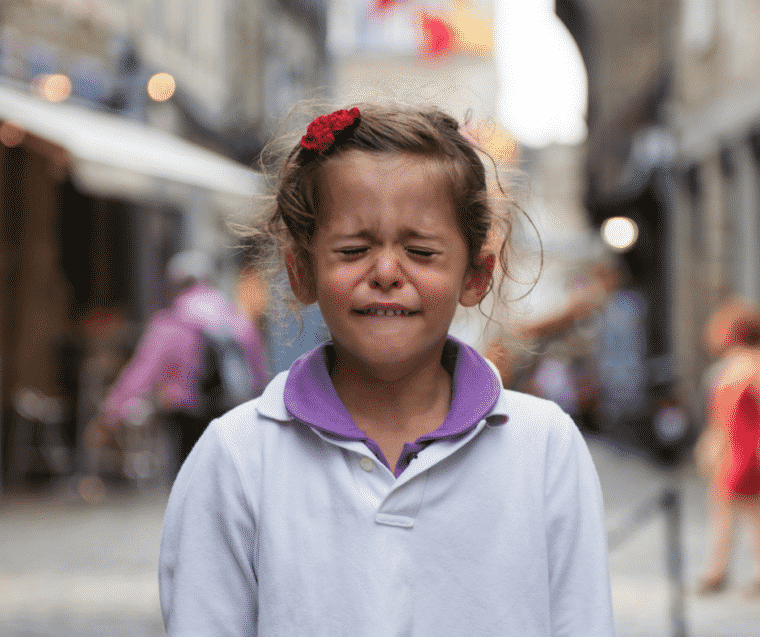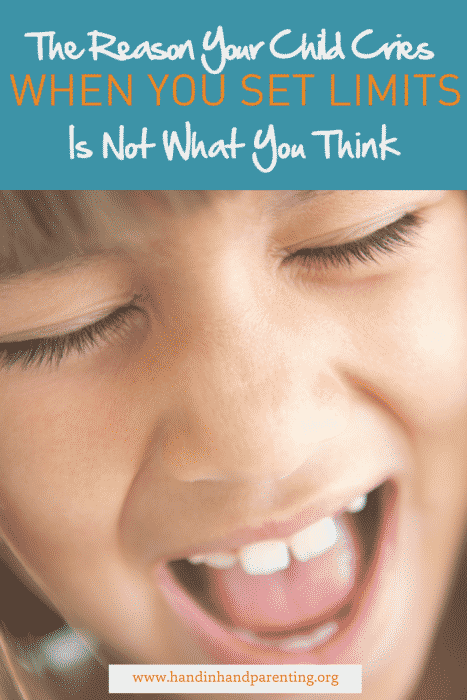![]() A guest post from Marilupe de la Calle
A guest post from Marilupe de la Calle
My daughter, age two, was showing signs of tension and off-track behavior. She was easily dissatisfied and cranky.
 As soon as we arrived back home after an outing, she demanded that we open a tin box filled with cookies that my friend had baked.
As soon as we arrived back home after an outing, she demanded that we open a tin box filled with cookies that my friend had baked.
Sensing that her behaviors were signs that she had some upset needing to be offloaded, I knew that she would benefit from me setting a limit. I gently told her that we needed to wait until her dad and sister were home to open the cookies together.
She did not like my response!
She darted to grab the box of cookies, and when I saw she wanted to throw it across the room, I brought the limit. I got close and physically stopped her, calmly and gently holding the box (without taking it from her) and I told her, in a neutral tone, “I'm sorry, sweetie, I can't let you do that.”
A Calm Limit Brings On a Tantrum, But That’s OK
After hearing that, her upset turned into a full-blown tantrum! She threw herself on the floor, screaming and raging. Even though I know this is the healthiest possible thing her mind and body can do to clear the emotions clogging her mind, it was still hard to witness.
I managed to stay firm – and kind – with the limit.
“I'm sorry, sweetie. We won't open the box until later.” I said it a few times, stayed close, and listened.
She kept on crying, avoiding any eye contact and at one point got up to go to the living room.
I quietly followed her and sat down again next to her, offering gentle touch. I stayed next to her and kept listening in a compassionate way, what we call Staylistening, for quite some time. She went from raging to crying in varying intensity cycles and I could see that, due to the length of her cry, she was probably using this opportunity to work on some other past hurts that were lingering in her mind.
Sometimes our children even let us know which hurts they are working on, and this time, she did.
After what seemed like a long time, she suddenly stopped crying, looked at me in the eye and said, “I fell from the stairs, Mommy.”
When Her Feelings Clear She Doesn't Mind About the Limit on the Cookies
She had fallen off the stairs more than a year earlier when she was learning to walk. Although she hadn't been physically hurt then, we had found it really scary. Now I could see she had returned to those feelings and was using this opportunity, centered on the cookies, to work through those old hurts and fears.
“Yes, baby, you did.” I replied, and then added, “That was scary. Remember that daddy helped you? He was scared, too.” She nodded and cried some more until she seemed to be done.
Then, as if nothing had happened, she got up, happily. With that issue resolved in her mind, at least for the time being, she went on refreshed and ready for a good day.
As for the cookies? She was totally OK with the idea that she had to wait for all of us to be together to open the box.
Limits set with kindness and without interference from our own emotions can be a gift, acting like can openers to other deeper feelings that were waiting to be released. I'm so glad I held this limit for her!
Why Wasn’t the Cry Actually About the Cookies?
 When children are scared or experience fear the emotions they feel can get stored away in the body. Over time, these emotions mount up, some big, some small, until finally, our children find a way to clear them – through laughter, sometimes, and anger or crying at other times.
When children are scared or experience fear the emotions they feel can get stored away in the body. Over time, these emotions mount up, some big, some small, until finally, our children find a way to clear them – through laughter, sometimes, and anger or crying at other times.
Children, when they feel good and connected are generally willing beings and happy. We see the off-track behavior, whether it’s whining about not wanting to leave the park, or teasing a sibling, or, as in this story, Marilupe’s daughter begging for the cookies, as signals that those emotions are getting ready to spill.
Marilupe’s gentle three-step approach to limits – listen, limit, listen – helped give her daughter something to trigger the emotion and the safety she needed to offload. Here, her daughter identified some past feelings about an event that were still worrying her, but often, we, as parents, don’t come to know about the feelings lingering in our children’s bodies and minds.
But when we set kind limits, like this, and listen as a child cries, we can be sure that they are doing all they need to get back to their tender, content and loving selves.
For more on the brain science behind this approach and why it is helpful to listen warmly as children cry read The Science Behind the Hand in Hand Tool of Staylistening.
Work with Marilupe
 Marilupe de la Calle is a Mexican mom living in the US with her husband and two amazing girls. You can connect with Marilupe on our website
Marilupe de la Calle is a Mexican mom living in the US with her husband and two amazing girls. You can connect with Marilupe on our website